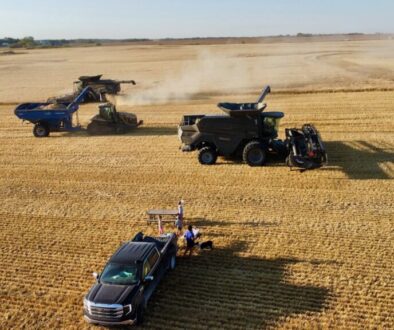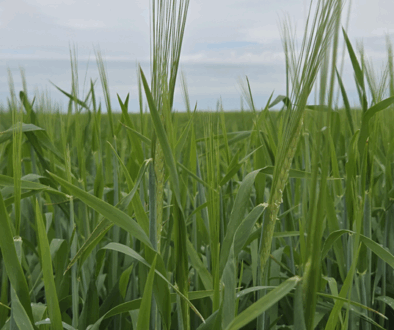Feeding Barley Grain to Beef Cattle
Murray Feist, M.Sc. P.Ag.
Provincial Livestock Specialist,
Saskatchewan Ministry of Agriculture
Barley grain is a feed source often used by cattle producers in Saskatchewan. The grain is well-balanced when feeding forage-based beef rations as it provides energy and protein that can complement all degrees of forage quality. Often, feed grade barley grain is comprised of seeds that were not able to meet the malt grading standard of crude protein, less than 13 per cent, no mycotoxin contamination and high-germination levels as per the Beef Cattle Research Council’s Feed Grains for Beef Cattle. Many times, these grains are brokered for feedlot and dairy purpose, purchased by commercial feed mills, filled by local contracts or simply fed on-farm.
Nutritionally, barley grain is often compared to wheat, oats, corn and more recently, peas, lentils and other grains. On a basis of total digestible nutrient (TDN) energy, barley is rated less than corn, peas and wheat and higher than oats, grain screenings and many commercial pellets. As a cereal grain, barley usually provides higher crude protein than corn, is similar in content to wheat and oats and less than pulse grains like peas. Like all other cereal grains grown in Western Canada, barley is low in calcium and will require additional supplementation. Phosphorus is relative in concentration with other cereal grains and as with all beef rations, proper mineral and vitamin supplementation is required according to proper stage of production (e.g. maintenance, gestation and lactation). Table 1. shows the nutrient content of barley and other feed grains used in beef rations in Saskatchewan.

Feed grade barley can be variable in yield and nutritional quality depending on the environmental conditions during the growing season, harvest and storage. Under normal growing conditions, feed grade barley often weighs 48 pounds per bushel or greater, has a normal kernel fill with starch deposition and is consistently sized amongst individual grains. Growing seasons that are affected by drought or other poor environmental conditions often result in reduced yields and test weights. As bushel weight decreases and lighter test weight results, there will be little impact on feed efficiency in high producing cattle (e.g. feedlot and backgrounding operations) until the bushel weight reaches 44 pounds per bushel or less. Lighter test weight barley of 43 to 44 pounds per bushel and less will be characterized by shrunken, shriveled kernels and as a result, lower energy (TDN) content. Barley grain weighing 48, 44, 42 and 38 pounds per bushel will contain approximately 84 per cent TDN, 82 per cent TDN, 80 per cent TDN and 77 per cent TDN (dry matter basis). Feed rations and barley grain inclusion will have to be adjusted to consider energy content provided according to bushel weight.
In general, whole barley can be fed to beef cattle but a fibrous seed coat protecting the endosperm will prevent thorough digestion of the starches and proteins within the seed. Often, producers will observe whole barley seed grains in the manure after feeding, indicating low digestion and use of the grain by the cow and wasted potential use. As chewing of whole barley grain by the cow does provide up to 42 to 55 per cent digestibility, some breakage and hull disruption by processing is often required to achieve 85 to 90 per cent digestibility. For cow-calf diets, dry rolling is currently the most common processing method that will result in a broken kernel of two to four pieces. The breakdown of the hull and the grain into pieces provides rumen microbes with access to the endosperm and the nutrients (starch and protein) contained within.
The starch from barley is rapidly digested in the rumen so over-processing/grinding the seed can result in excessive fines and smaller seed particles that are highly and rapidly digestible. When highly-processed barley is combined with high feeding rates or sudden introduction in the ration, rumen upset (acidosis) may occur. Regular weight barley (48 pounds per bushel) is desirable for feeding as the grains are often similar in size and shape. Consistency in physical characteristics is desirable for the purposes of milling and rolling as it isn’t necessary to continually reset machinery to process the grains. When crops are affected by drought or flooding, barley grains can be lighter in bushel weight, shriveled and are random in size. This makes efficiency of processing less effective when smaller kernels escape cracking or grinding and remain in whole seed form.
Using barley grain in a cow-calf diet is not overly complex. Often, barley grain is incorporated to provide an additional source of energy to help meet the nutritional requirements of the cow or calf, dependent on the stage of production. Required supplementation levels (in pounds per head) are lower for cows in mid-gestation stage of production than for cows in late-gestation or lactation. Also, supplementation will be lower for rations based on legume, legume/grass, good quality grass or silage than for rations based around straw, oat hulls or low quality feeds. Barley starch is rapidly available for digestion. It is recommended that should a diet include over eight pounds of barley per head per day, that total barley fed should be evenly split into morning and evening feedings to prevent rumen upset. Producers should pay attention to proper starch/available protein balance, should barley inclusion levels increase to ensure rumen microbes have adequate nitrogen in balance with increased starch. For most cow-calf rations, a balanced mineral and vitamin supplementation program will be adequate. However, should barley grain be increased in levels in the ration, a nutritionist should be consulted to ensure that adequate calcium requirements are met as barley grain contains marginal calcium levels of .07 per cent.
Like other cereal grains grown in Saskatchewan, barley is susceptible to mycotoxin contamination. Ergot and fusarium infection can occur if environmental growing conditions are appropriate and in the case of fusarium, sometimes can be enhanced if storage conditions are favorable for mold growth. Ergot bodies growing in the seed head can be visually identified and any infected parent crops, or screenings taken from ergot infected barley crops, should be tested for ergot alkaloids if it’s being considered for feeding. Fusarium contamination during the growing season is visible at harvest with the seeds presenting discolored growth. These infections can be identified at harvest and if stored under moist harvest conditions may propagate. As with ergot, any suspected or identified fusarium infection of barley or barley screenings should be tested at a certified testing laboratory prior to including it in a rations.
Beef cattle producers looking to access sample rations that incorporate barley grain for feed can access the Saskatchewan Ministry of Agriculture’s Beef Cow Rations and Winter Feeding Guidelines. It contains wintering beef rations and identifies typical body sizes and stage of production.




